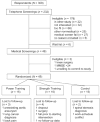Lower extremity muscle function after strength or power training in older adults
- PMID: 19940322
- PMCID: PMC4318571
- DOI: 10.1123/japa.17.4.416
Lower extremity muscle function after strength or power training in older adults
Abstract
It is unclear whether strength training (ST) or power training (PT) is the more effective intervention at improving muscle strength and power and physical function in older adults. The authors compared the effects of lower extremity PT with those of ST on muscle strength and power in 45 older adults (74.8 +/- 5.7 yr) with self-reported difficulty in common daily activities. Participants were randomized to 1 of 3 treatment groups: PT, ST, or wait-list control. PT and ST trained 3 times/wk for 12 wk using knee-extension (KE) and leg-press (LP) machines at approximately 70% of 1-repetition maximum (1RM). For PT, the concentric phase of the KE and LP was completed "as fast as possible," whereas for ST the concentric phase was 2-3 s. Both PT and ST paused briefly at the midpoint of the movement and completed the eccentric phase of the movement in 2-3 s. PT and ST groups showed significant improvements in KE and LP 1RM compared with the control group. Maximum KE and LP power increased approximately twofold in PT compared with ST. At 12 wk, compared with control, maximum KE and LP power were significantly increased for the PT group but not for the ST group. In older adults with compromised function, PT leads to similar increases in strength and larger increases in power than ST.
Conflict of interest statement
The authors do not have any financial interest or conflict of interest to disclose.
Figures



Similar articles
-
High-velocity resistance training increases skeletal muscle peak power in older women.J Am Geriatr Soc. 2002 Apr;50(4):655-62. doi: 10.1046/j.1532-5415.2002.50159.x. J Am Geriatr Soc. 2002. PMID: 11982665 Clinical Trial.
-
The effects of strength and power training on single-step balance recovery in older adults: a preliminary study.Clin Interv Aging. 2014 Apr 17;9:697-704. doi: 10.2147/CIA.S59310. eCollection 2014. Clin Interv Aging. 2014. PMID: 24790422 Free PMC article. Clinical Trial.
-
Strength training at high versus low external resistance in older adults: effects on muscle volume, muscle strength, and force-velocity characteristics.Exp Gerontol. 2013 Nov;48(11):1351-61. doi: 10.1016/j.exger.2013.08.010. Epub 2013 Aug 30. Exp Gerontol. 2013. PMID: 23999311 Clinical Trial.
-
Chronic Effects of Different Intensities of Power Training on Neuromuscular Parameters in Older People: A Systematic Review with Meta-analysis.Sports Med Open. 2023 Oct 24;9(1):98. doi: 10.1186/s40798-023-00646-9. Sports Med Open. 2023. PMID: 37874417 Free PMC article.
-
The Effects of High- Versus Low-Intensity Power Training on Muscle Power Outcomes in Healthy, Older Adults: A Systematic Review.J Aging Phys Act. 2019 Jun 1;27(3):422-439. doi: 10.1123/japa.2018-0054. Epub 2019 Mar 6. J Aging Phys Act. 2019. PMID: 30300075
Cited by
-
Optimizing the benefits of exercise on physical function in older adults.PM R. 2014 Jun;6(6):528-43. doi: 10.1016/j.pmrj.2013.11.009. Epub 2013 Dec 19. PM R. 2014. PMID: 24361365 Free PMC article. Review.
-
Comparison of traditional and recent approaches in the promotion of balance and strength in older adults.Sports Med. 2011 May 1;41(5):377-400. doi: 10.2165/11539920-000000000-00000. Sports Med. 2011. PMID: 21510715 Review.
-
The Cooperative Lifestyle Intervention Program-II (CLIP-II): design and methods.Contemp Clin Trials. 2013 Nov;36(2):382-93. doi: 10.1016/j.cct.2013.08.006. Epub 2013 Aug 23. Contemp Clin Trials. 2013. PMID: 23974035 Free PMC article. Clinical Trial.
-
Effects of Explosive vs. Strength Resistance Training on Plantar Flexor Neuromuscular and Functional Capacities in Institutionalized Older Adults: A Randomized Controlled Trial.J Funct Morphol Kinesiol. 2024 Dec 7;9(4):261. doi: 10.3390/jfmk9040261. J Funct Morphol Kinesiol. 2024. PMID: 39728245 Free PMC article.
-
Of Sound Mind and Body: Exploring the Diet-Strength Interaction in Healthy Aging.Front Nutr. 2020 Aug 28;7:145. doi: 10.3389/fnut.2020.00145. eCollection 2020. Front Nutr. 2020. PMID: 32984401 Free PMC article. Review.
References
-
- Aniansson A, Hedberg M, Henning GB, Grimby G. Muscle morphology, enzymatic activity, and muscle strength in elderly men: A follow-up study. Muscle & Nerve. 1986;9:585–591. - PubMed
-
- Bassey EJ. Longitudinal changes in selected physical capabilities: Muscle strength, flexibility and body size. Age and Ageing. 1998;27(Suppl. 3):12–16. - PubMed
-
- Bassey EJ, Fiatarone MA, O’Neill EF, Kelly M, Evans WJ, Lipsitz LA. Leg extensor power and functional performance in very old men and women. Clinical Science (London, England : 1979) 1992;82:321–327. - PubMed
-
- Bassey EJ, Harries UJ. Normal values for handgrip strength in 920 men and women aged over 65 years, and longitudinal changes over 4 years in 620 survivors. Clinical Science (London, England : 1979) 1993;84:331–337. - PubMed
-
- Bean J, Herman S, Kiely DK, Callahan D, Mizer K, Frontera WR, et al. Weighted stair climbing in mobility-limited older people: A pilot study. Journal of the American Geriatrics Society. 2002;50:663–670. - PubMed
Publication types
MeSH terms
Grants and funding
LinkOut - more resources
Full Text Sources

